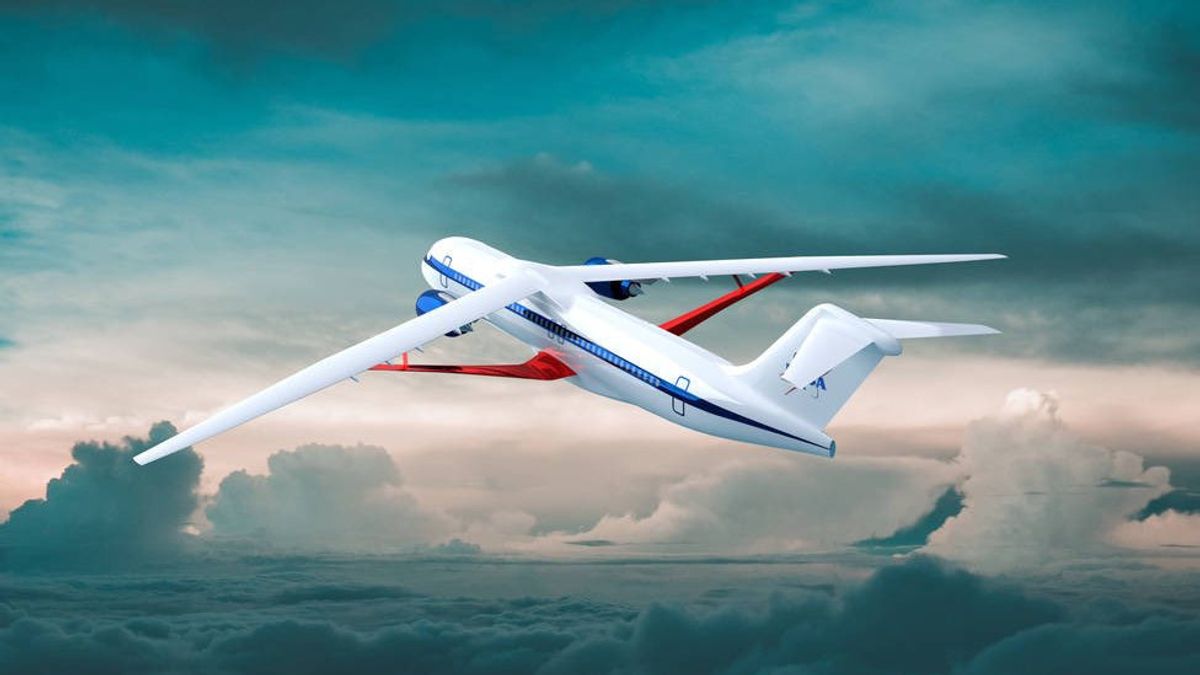JAKARTA - NASA and Boeing are working together to develop a radical new wing design and promise to make single-aisle-type passenger aircraft lighter, cleaner, and more efficient, with the potential to reduce emissions by 30 percent.
The collaboration between NASA and Boeing involves full-sized development, testing, and flight demonstrators to be named X-66A by the United States Air Force. NASA is committed to investing $425 million, while Boeing and their industrial partners are investing USD 725 million (IDR 10.9 trillion).
The aircraft's new design uses longer and thinner wings with support from a strut, known as the Transonic Truss-Braced Wing. This design takes advantage of a better potential planning, thus requiring less fuel to drive it forward.
The United States Air Force gave the project an experimental X-plane status, making X66-A one of the revolutionary X-planes such as the North American X-15 test plane which still holds a world record for its highest altitude (67 miles) and highest speed (Mach 6.7).
NASA and Boeing's main goal with the X66-A is to encourage the "decarbonization of the aerospace industry" to save Earth. NASA administrator Bill Nelson said that the X66-A will form a future of aerospace where aircraft are more environmentally friendly, clean, and calmer, and create new possibilities for American airplane and industrial users.
JUST ANNOUNCED @ #AIAAaviation: We've got an X designation for the Sustainable Flight Demonstrator!Introducing, X-66A ✈️🍃The new X-plane seeks to inform a potential new gen of more sustainable single-aisle aircraft-the workhorse of passenger airlines. https://t.co/zbB7eIZlFt pic.twitter.com/BvN8BxDKYJ
— NASA Aeronautics (@NASAaero) June 12, 2023
JUST ANNOUNCED @ #AIAAaviation: We've got an X designation for the Sustainable Flight Demonstrator!Introducing, X-66A ✈️🍃The new X-plane seeks to inform a potential new gen of more sustainable single-aisle aircraft-the workhorse of passenger airlines. https://t.co/zbB7eIZlFt pic.twitter.com/BvN8BxDKYJ
By combining advanced boost plans, new aerospace materials, and a new electronic system architecture, the associated wing promises to reduce fuel consumption by up to 30 percent compared to the current best aircraft.
However, this comparison only applies when compared to the current aircraft. In 2019, Boeing estimated that the Transonic Truss-Braced Wing could reduce emissions and fuel costs by up to 60 percent compared to the aircraft created in 2005, some of which are still in use today.
NASA stated that the X66-A is the first X-plane made with a special purpose of helping the United States achieve its fully carbon-neutral flight industry target, as stipulated in the United States Aviation Climate Action Plan.
另请阅读:
Bob Pearce, Associate Administrator for NASA's Aeronautics Research Mission Directorate, stated that to achieve the goal of zero flight emissions by 2050, a transformative aircraft concept is needed as will be piloted in X-66A.
The plan, the X-66-A is to build a demonstrator on the framework of the McDonnell Douglas (now owned by Boeing) MD-90, a single-aisle passenger plane that can accommodate 130 to 210 passengers, which is also used in the DC-9 family of aircraft.
The X-66A is scheduled to fly in 2028, hoping Boeing can launch the entire fleet with this new design in the mid to late 2030s.
At the Paris Air Show, Boeing Commercial Airplanes CEO Stan Deal is faced with questions from the media about the company's schedule feasibility. Deal shows that they have been working with NASA for a decade in the SUGAR (Subsonic Ultra Green Aircraft Research program) and the Transonic Truss-Braced Wing.
"We're not starting from scratch," said Deal. "We've actually been doing it for years."
With this new wing design innovation, it is hoped that the aviation industry can reduce carbon emissions produced by single-aisle passenger aircraft and lead to a more environmentally friendly future.
The English, Chinese, Japanese, Arabic, and French versions are automatically generated by the AI. So there may still be inaccuracies in translating, please always see Indonesian as our main language. (system supported by DigitalSiber.id)


















